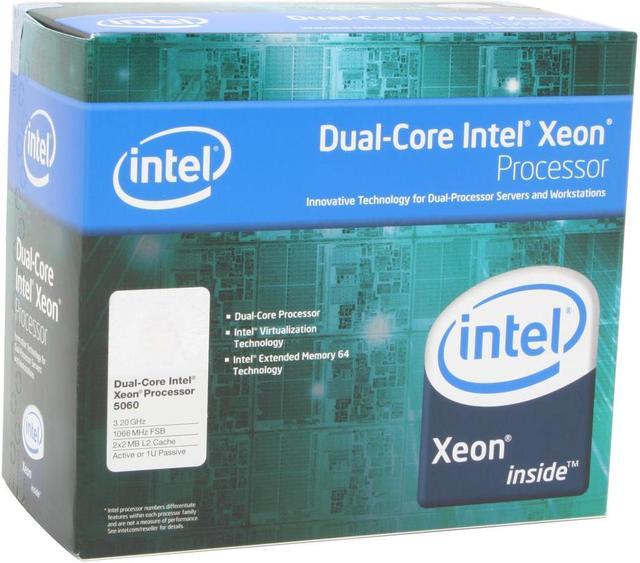Your Browsing History

Make informed decisions with expert advice. Learn More
Any questions? Our AI beta will help you find out quickly.
 Dual-core processing with 2x2MB L2 CacheThe Intel Xeon 5060 processor features two complete processor cores in one physical package running at the same frequency. Significant performance headroom, especially for multi-threaded applications, help boost system utilization through virtualization and application responsiveness. Its 2 x 2MB L2 cache (total 4MB) means more data can be stored closer to processor execution units for faster data access, resulting in higher system throughput and shorter system latency.
Dual-core processing with 2x2MB L2 CacheThe Intel Xeon 5060 processor features two complete processor cores in one physical package running at the same frequency. Significant performance headroom, especially for multi-threaded applications, help boost system utilization through virtualization and application responsiveness. Its 2 x 2MB L2 cache (total 4MB) means more data can be stored closer to processor execution units for faster data access, resulting in higher system throughput and shorter system latency. Intel Virtualization Technology (Intel VT)Intel Virtualization Tehcnology makes it even easier to increase server utilization in your data center by consolidating more applications, while improving data center reliability and adding robustness to virtualized systems.
Intel Virtualization Technology (Intel VT)Intel Virtualization Tehcnology makes it even easier to increase server utilization in your data center by consolidating more applications, while improving data center reliability and adding robustness to virtualized systems. Hyper-Threading Technology (HT Technology)Hyper-threading enables multi-threaded software applications to execute two software threads in parallel, thereby improves processor utilization and system responsiveness. Dual-processor platforms utilizing dual-core Intel Xeon processors with HT support realize up to 8 logical processors in a single system.
Hyper-Threading Technology (HT Technology)Hyper-threading enables multi-threaded software applications to execute two software threads in parallel, thereby improves processor utilization and system responsiveness. Dual-processor platforms utilizing dual-core Intel Xeon processors with HT support realize up to 8 logical processors in a single system. Intel Extended Memory 64 Technology (Intel EM64T)Enhances next-generation IA-32 platforms with 64-bit addressability and related instructions, allowing flexibility for 64-bit and 32-bit applications and operating systems.
Intel Extended Memory 64 Technology (Intel EM64T)Enhances next-generation IA-32 platforms with 64-bit addressability and related instructions, allowing flexibility for 64-bit and 32-bit applications and operating systems. Demand-Based Switching (DBS) with Enhanced Intel SpeedStep Technology (EIST)EIST allows the system to dynamically adjust processor voltage and core frequency, which can helps reduce average system power consumption and potentially improves system acoustics.
Demand-Based Switching (DBS) with Enhanced Intel SpeedStep Technology (EIST)EIST allows the system to dynamically adjust processor voltage and core frequency, which can helps reduce average system power consumption and potentially improves system acoustics. Execute Disable Bit (EDB)Intel's Execute Disable Bit function can prevent certain classes of malicious "buffer overflow" attacks when combined with a supporting operating system. Execute Disable Bit allows the processor to classify areas in memory by where application code can execute and where it cannot. When a malicious worm attempts to insert code in the buffer, the processor disables code execution, preventing damage or worm
Execute Disable Bit (EDB)Intel's Execute Disable Bit function can prevent certain classes of malicious "buffer overflow" attacks when combined with a supporting operating system. Execute Disable Bit allows the processor to classify areas in memory by where application code can execute and where it cannot. When a malicious worm attempts to insert code in the buffer, the processor disables code execution, preventing damage or worm